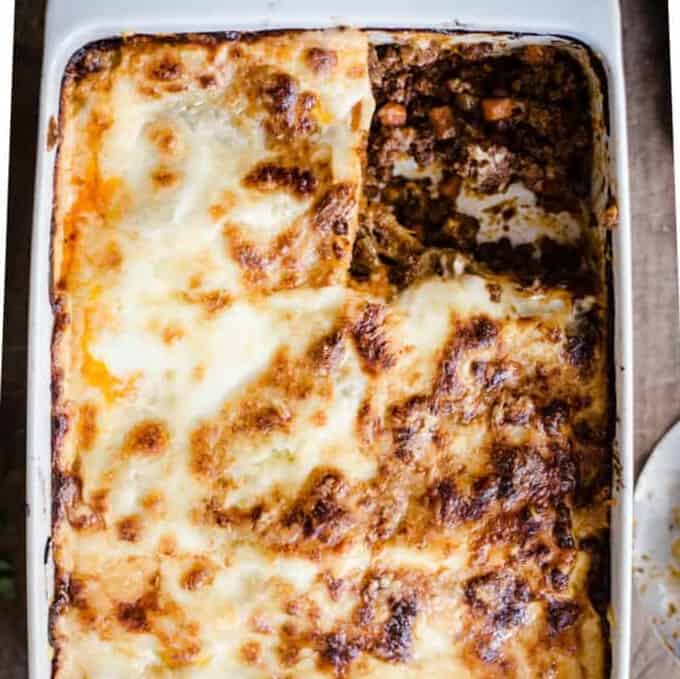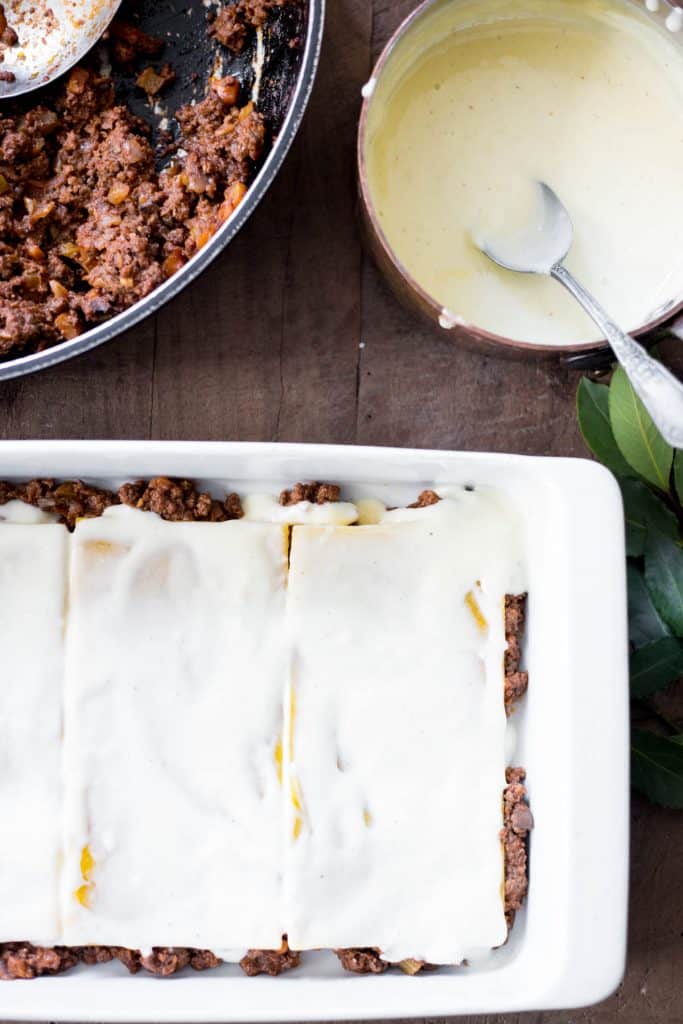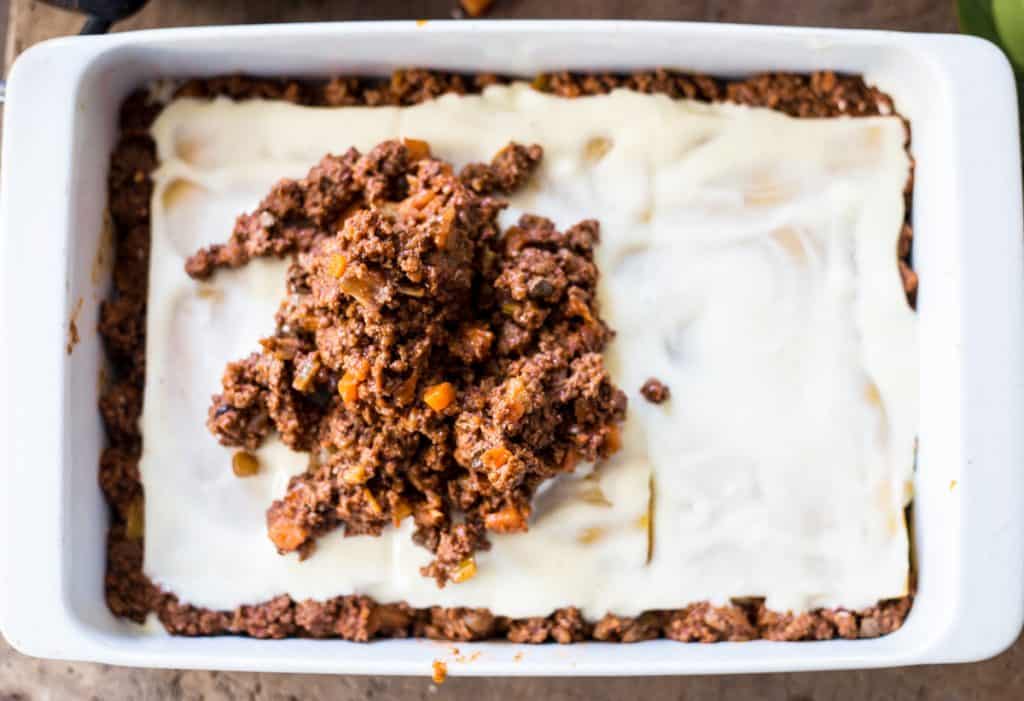This post contains affiliate links. Please read my disclosures.
This Gluten-Free Lasagne is unbeatable. Rich beef ragu is layered between gluten-free pasta and a creamy cheesy sauce. Topped with mountains of grated gruyère and mozzarella then baked until golden. Here are all the tips and step by step advice to make your favourite lasagne indistinguishably gluten-free.
Every time I share a lasagne in company there ensues a hotly contested debate over the best kind of lasagne. Do you prefer it ultra saucey? Really cheesy or overly meaty? Do you like it to stand proudly upright so you can see all the layers or melt into a puddle of its own deliciousness.
It’s usually agreed that whichever lasagne you grew up eating as a child is the measuring stick to which all future lasagnes should be held accountable to.

Lasagne or lasagna?
Let’s begin with the spelling. My spell check does not like fact that I spell lasagne with an ‘e’ at the end. However, I’m not being difficult.
The Italian word ‘lasagna’ really refers to a singular sheet of lasagna pasta. Lasagne is the plural and since the dish in question uses many sheets of pasta, Lasagne alla Bolognese, is the full Italian name of the dish in question.
In the UK we shorten the dish to ‘Lasagne.’ However in the US the same dish is spelt Lasagna.
But is it the same dish?
What is lasagne?
The Italian Lasagne alla Bolognese
The Italian version is of course is the basis for all other incarnations of lasagne. It generally refers to wide flat pasta sheets layered with a classic béchamel (white) sauce, a meaty ragu then topped with grated parmesan and baked in the oven. Made authentically it can easily be cut into portions.
The British Lasagne
Like many British I grew up with something similar. Well, most of the ingredients are the same anyway. The main difference was the copious amount of cheddar cheese added to the béchamel. Probably quadruple the amount of cheese sauce one might consider appropriate. When my mum made it the whole dish cascaded into a meaty cheese feast with a few layers of pasta hiding somewhere inside. Sublime but you pretty much need a spoon to eat it.
The American Lasagna
In another variation on lasagne, popular with American cooks, the béchamel is replaced with a mixture of ricotta, mozzarella and parmesan cheese. Since this version eschews the béchamel it is easy to make gluten-free. I have tried this method before and thought it was lovely though quite different from what I was used to.
Let’s face it, any kind of lasagne is always pretty great. However, for my favourite Gluten-Free Lasagne I tend to rely upon the best bits of all these different versions.

What makes this Gluten-Free Lasagne so brilliant?
- Rich and tomatoey beef ragu. Made even more flavourful by the inclusion of a smattering of chopped chicken livers to enhance the meatiness.
- A really good cheese béchamel. I use the Best Gluten-Free Cheese Sauce for between the layers. It’s smooth, creamy and deeply cheesy thanks to the use of nutty gruyère.
- Mozzarella topping! This is a new addition to my go-to lasagne and it gives the top layer an ultra gooey cheesy crown.
- Blanching the dried pasta sheets. This extra step really makes a difference to the finished texture of the lasagne.
Speaking of…
Do you have to pre-boil the lasagne sheets?
This is a new step that I have started taking when making lasagne and I wish I had always made time for it. Even though the packets of lasagne may say that no pre-cooking is required, just a minute of blanching the pasta sheets in boiling water really improves the finished texture. Especially the case with gluten-free lasagne sheets which are often a little tougher.
How do you blanch lasagne sheets?
Choose a saucepan which is wide enough to fit a sheet of lasagna then fill up to a third with water and a pinch of salt.
Whilst you are bringing the water up to boil spread a large sheet of baking parchment on your work surface ready for the blanched pasta to rest on.
Once the water is boiling place in one lasagna sheet with a pair of tongs. Boil the pasta for 1 minute then remove with the tongs and place on the baking parchment to rest whilst you blanch the remaining sheets.
Repeat with 9 sheets of lasagne, blanching one at a time.
Blanching the pasta sheets one at a time ensures they don’t stick together.
PRO TIP
Boil the pasta concurrently with assembling the lasagne. By the time three pasta sheets are blanched then it should be about time to layer into the lasagne.
How do you make Gluten-Free Lasagne?
- Saute onions, carrots and celery in a wide bottomed saucepan until the onions are translucent.

- Add the beef mince and chicken livers with garlic and seasoning and stir in until the beef has crumbled and browned.

- Pour in a glass of red wine, let bubble for a couple of minutes.

- Stir in the tomato puree, thyme, bay leaves and passata.


- Place a lid on the ragu and simmer for 30 minutes.

- Whilst the ragu is simmering you can make the cheese sauce. For detailed instructions on making the Best Gluten-Free Cheese Sauce visit my post here.

- Pre-heat the oven to 180°C/ 160°C fan / gas mark 4.
- Choose a 30cm x 20cm x 7cm baking dish and begin to assemble the lasagne.
- Start with spreading a third of the ragu at the bottom of the dish.

- Then arrange three blanched pasta sheets on top.

- Spread a third of the cheese sauce over the pasta sheets, making sure to totally cover them right to the edges of the pasta.

- Layer the ragu, then the pasta then the cheese sauce again.

- Assemble a final layer of ragu, pasta and cheese sauce. Sprinkle over some torn mozzarella and grated gruyère.

- Bake in the oven for 30 minutes. Remove from oven and allow to rest for 15 minutes before cutting and serving.

PRO TIPS
- If you are really averse to the inclusion of the chicken livers then simply replace the livers with diced smoked streaky bacon.
- If you err on my Mum’s side of the more saucy lasagne then you just need to increase the amount of cheese sauce, by even as much as half again.
- Blanch the pasta sheets. This step is simply a must.
- Make sure you top your lasagne generously with the cheese sauce. Pay particular attention to the top layer. The pasta sheets need to be well covered with sauce and then cheese to stop the pasta from drying out.
- Rest the lasagne for 15 minutes before serving – it will hold its shape better and you won’t scorch your tongue on the cheese
- Serve with a simple salad.
How do you make bolognese ragu in the Instant Pot?
By making the bolognese ragu in the Instant Pot you can get a deeper flavour quicker. I suggest below that you might want to make the lasagne ahead so the flavours can really develop. If you make your ragu in the Instant Pot there is no need for that at all.
- Follow the instructions for making the ragu as written in the method below just switch up the wide bottomed saucepan for the Instant Pot.
- Instead of simmering the ragu for 30 minutes after you have added the passata you will need to seal the lid of the Instant Pot and cook on high pressure for 20 minutes.
- Naturally release for 10 minutes before switching to quick release and removing the lid.
- Assemble the lasagne as instructed.

Can you make Gluten-Free Lasagne ahead?
Absolutely and actually I usually do. Lasagne is one of those dishes that tastes even better the next day after the flavours have had a bit of time to rest and deepen. Just place in the oven with foil over the top to stop the cheese from over-browning for 40 minutes at 180°C.
Can you freeze Gluten-Free Lasagne?
Yes! And in fact I making a couple for my freezer to have up my sleeve for the first few weeks of the twins being born. There is no way I’m going to be up for cooking meals whilst looking after 4 children, enduring the sleepless nights and recovering from a probable c-section. Lasagne is the perfect freezer meal as it’s all there in the dish.
Wrap the lasagne up well in cling film and tin foil to freeze for up to two months. Remove from the freezer to defrost overnight. Cover with foil and bake for 40 minutes at 180°C/ 160°C fan / gas mark 4.
All you need is a little side salad to accompany. And I intend on delegating that to my husband.
Would you like some ideas for more gluten-free family meals?
Gluten-Free Shepherd's Pie
Gluten-Free Cauliflower Cheese
Gluten-Free Fish and Chips
Simple Salmon Fishcakes
Bangers and Mash
Chicken and Leek Pie
Barbecue Spare Ribs
If you make Gluten-Free Lasagne then please leave a comment below and/or give the recipe a rating. If you then go on to use this recipe as a launch pad for your own culinary creation then I’d also love it if you’d share it and tag me on Instagram. It is so lovely for me to see your versions and variations of my recipes.

Gluten-Free Lasagne
Ingredients
- 2 tablespoons olive oil
- 1 large white onion - finely diced
- 2 sticks celery - finely diced
- 2 carrots - peeled and finely diced
- 1 kg beef mince
- 50 g chicken livers - finely chopped
- 2 garlic cloves - crushed
- ¾ teaspoon kosher salt
- ½ teaspoon ground black pepper
- 125 ml red wine
- 2 tablespoons tomato puree
- 2 sprigs fresh thyme
- 2 fresh bay leaves
- 400 g passata
- 9 sheets gluten-free lasagne
- 1 portion of Gluten-Free Cheese Sauce - see notes
- 75 g mature cheddar or gruyère cheese
- 150 g mozzarella - torn
Instructions
- Heat the olive oil for a couple of minutes in a large wide bottomed saucepan.
- Add in the onion, celery and carrots and fry on a medium heat until the onions are translucent.
- Add the beef mince, chicken livers, the crushed garlic, salt and pepper. Fry together until the mince has browned.
- Pour in the red wine and stir together until the red wine begins to bubble.
- Add the tomato puree, thyme and bay leaves. Stir in the passata and bring to a gentle boil.
- Turn the heat down and simmer with a lid on for 30 minutes whilst you prepare the cheese sauce.
Cheese Sauce
- For detailed instructions on the cheese sauce see notes.
Blanching the Pasta
- Fill saucepan, wide enough to fit a lasagna sheet, up to a third with water and a pinch of salt.
- Whilst you are bringing the water up to boil spread a large sheet of baking parchment on your work surface ready for the pasta to rest on.
- Once the water is boiling place in one lasagna sheet with a pair of tongs. Boil the pasta for 1 minute then remove with the tongs and place on the baking parchment to rest whilst you blanch the remaining sheets.
- Repeat with 9 sheets of lasagne, blanching one at a time.
Assembly
- Pre-heat the oven to 180°C/ 160°C fan / gas mark 4.
- Choose a 30cm x 20cm x 7cm baking dish and begin to assemble the lasagne.
- Spread a third of the ragu at the bottom of the dish.
- Then arrange 3 pre-blanched pasta sheets on top.
- Spread a third of the cheese sauce over the pasta sheets, making sure to totally cover them right to the edges of the pasta.
- Layer the ragu, then the pasta then the cheese sauce again.
- Assemble a final layer of ragu, pasta and cheese sauce. Sprinkle over the torn mozzarella and grated gruyère.
- Bake in the oven for 30 minutes. Remove from oven and allow to rest for 15 minutes before cutting and serving.















Maria says
Hi,
This looks amazing!
Have you ever tried to make your own gf pasta? I’m now corn intolerant as well, so am thinking of making my own, but wouldn’t know how to make it bind together. Rice flour would be my first choice, but how to give it that pasta feel, rather than noodles?
Georgina Hartley says
Yes I have - I haven't gotten around to publishing one yet though. Nut flours are the best for pasta due to the high protein content so it binds together really well. My favourite flour to use is Chestnut flour. Almond flour is also very lovely. Rice flour would be a little gritty and you are right, would not bind very well.
Priya says
Hi there. This looks great!
Just wondering-do you freeze your lasagne before or after cooking it?
Georgina Hartley says
Hi Priya, I usually freeze after cooking.
tracy says
what brand of gf lasagne do you suggest for this ?
Georgina Hartley says
It looks like you might be based in the US so we might not have the same brands available to us. However, there is not much choice of gf lasagne sheets in the UK. All the ones available in my local supermarket are rice flour and cornflour based with around 55-60% cornflour. I have found these all work well but I do recommend always blanching the pasta sheets before using.